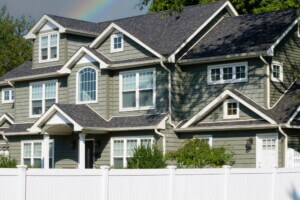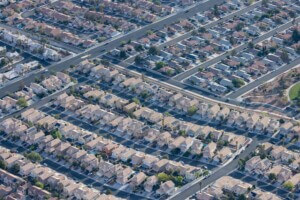Cookie-cutter Levittowns epitomize the post–World War II generation’s housing: Shaped by subsidies and segregation practices like redlining, vast tracts of cul-de-sacs and ranch homes filled up with white Americans emptying from the cities. Now, as a new generation stands to form 14 million new households over the next decade, the suburbs are poised for major changes.
How and where the next wave lives are the major questions put forth by “Housing in the Evolving American Suburb,” the 2016 report from the Urban Land Institute (ULI), a nonprofit developer and real estate research group based in Washington, D.C. Its analysis takes a big-picture snapshot of America’s suburbs in an attempt to update and more accurately reflect demographics and spread beyond Levittown. Seeing the suburbs figuring prominently in issues ranging from aging to immigration and economic growth, the report aims to create “a new analytic framework for classifying suburban housing markets.”
Drawing extensively from census data, the ULI—working with real estate consultants RCLCO—used factors such as housing types, population density, employment density, and distance from city centers to identify the suburban areas outside of America’s 50 largest metro areas. Organized by census tract, each area is classified into five suburban categories based on land value and a host of development trends.
Using these definitions, one immediate takeaway was that the suburbs are growing. “There’s absolutely…an outward migration from metro areas and regions based on the cost of living, which is principally the cost of housing,” said Stockton Williams, executive director for the ULI Terwilliger Center for Housing. Furthermore, the newer, more peripheral, and affordable suburbs are growing faster in comparison with older suburbs, regardless of whether the latter were wealthy or low income. And, contrary to popular perception, the suburbs are increasingly more diverse. By one estimate, suburban America was nearly 90 percent white in 1980. Now, while what the ULI defines as “economically struggling” suburbs are 62.1 percent minority (a definition that includes all races except non-Hispanic whites), “established high-end” and “stable middle income” suburbs are 33.8 percent and 51.2 percent minority, respectively. By comparison, non-Hispanic whites were an estimated 61.6 percent of the national population in 2015. However, the report and its accompanying online map (available at RCLCO’s website) make it impossible to distinguish what minorities make a census tract diverse. Moreover, segregation can still persist, depending on your standards and how close you look—a fall 2014 Harvard GSD studio still found the legacy of suburban segregation alive and well in Long Island’s Nassau County, which the report identifies mostly as “stable middle income.” While identifying that form of discrimination was not the report’s goal, Williams predicted that immigrants in particular would shape suburbs in the future. He said demand for newer, more peripheral, but higher-end suburbs will “increasingly be driven by second- and third-generation immigrants.”
Also contrary to population conception is the suburban demographic: 75 percent of 25- to 34-year-olds in the report’s top-50 metro areas lives in suburbs. That age group (millennials) may drive major national changes there. “There are still a lot of millennials who have not really formed households, or even if they have, have not even begun to fully express what we expect to be their purchasing power and their preferences in the housing market,” said Williams. According to previous ULI studies, 75 percent of millennials plan to move in the next five years, and that group has a strong preference for car-optional neighborhoods that are diverse and pedestrian- and bicycle-friendly—in other words, compact mixed-use developments. So what will happen when millennials want to upgrade the sizes of their dwellings, form households, or pursue home ownership, especially when as of 2014 the median household income for those aged 25 and 34 was $54,243?
More prosperous millennials may remain in cities or move to newer, higher-end suburbs—ones developed with dense, walkable, mixed-use downtowns as amenities. For the rest, other possible destinations arethe many “economically challenged” suburbs well situated near urban cores. “There, we could see a reinvestment, meaning an influx of younger families, or families of any age who want to buy, who can buy more…because prices are lower,” Williams said. Such a phenomenon is already underway near Washington, D.C., in parts of Prince George’s County, Maryland, which Williams said is “now attracting residential investment and mixed-use and even arts and cultural redevelopment.”
Another complicating factor is the fate of older suburban housing stock. Though it’s unclear at what rate those homes will enter the market, when they do, there may be little demand from younger generations for homes “that were built in the ’60s, ’70s, ’80s, largely to meet the needs and preferences of the nuclear family unit of that era, in communities that may not always reflect today’s preferences,” said Williams. Lastly, the prospect of driverless and electric vehicles—estimated to enter widespread use in 20 to 30 years, according to the report—could be highly disruptive. Autonomous and shared vehicles could vastly curtail parking requirements that stifle density while making long-distance car commuting more amenable. Electric vehicles could also make the suburbs more sustainable.
While some have portrayed the report as another round in the city-versus-suburb debate, that’s not Williams’s takeaway. He argues that the suburbs’ range of housing options make them integral to the success of their cities and vice versa. “You really are seeing pretty significant and sustained growth in a number of the metro areas…where housing is more affordable.” But a range of factors—from fair-housing enforcement to driverless cars, aging in place, and millions of households’ preferences—have yet to play out in each region.










